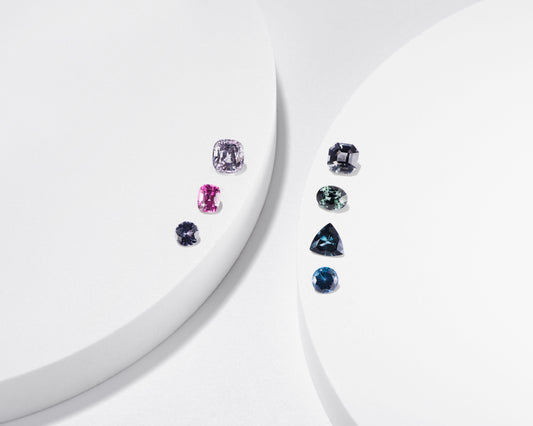LEARN ABOUT OUR ETHICAL COLOURED GEMSTONES
TRANSPARENT AND ETHICAL SOURCING
HAMISH WHITING
GIA Gemologist and HRD Antwerp Diamond Grader
All of our coloured gemstones are responsibly sourced by our GIA Gemologist, Hamish Whiting, from small-scale, independent artisanal mines in both developed countries such as Australia and United States of America (Montana), and developing countries such as Sri Lanka, Nigeria, and Madagascar.
We limit our supply chain as much as possible by buying either directly from the miners, the gemstone cutters, or local trusted brokers who work directly with the miners. Hamish has formed strong relationships with our trusted suppliers in each mining area to ensure that the mining operations follow ethical practices.

OUR SAPPHIRES
Sapphire is a precious gemstone, a variety of the mineral corundum, consisting of aluminium oxide with trace amounts of elements such as iron, titanium, chromium, vanadium, or magnesium. It is typically blue, but natural "fancy" sapphires also occur in yellow, purple, orange, and green colours; "parti sapphires" show two or more colours. Red corundum stones also occur, but are called rubies not sapphires
CHARACTERISTICS
Nigerian sapphires come in a range of beautiful hues including, teal, green, parti blue/green, and royal blue. Known for their naturally rich colour saturation and excellent clarity, the vast majority of our Nigerian sapphires are also unheated. This means that they have not been subjected to any form of heat treatment to enhance their colour or clarity (a common practice in sapphires from other locations).
We have an incredible collection of hand-selected unheated Nigerian sapphires in our collection. One of our favourite gemstones, Nigerian sapphires offer one of the most beautiful sources of sapphires as well as very reasonably priced compared to more established sapphire regions.
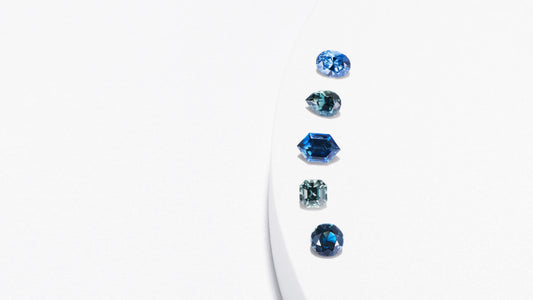
SOURCING
- Our Nigerian sapphires come from the agricultural areas around Gombe, Antang, and Mambilla in the central/northern highlands, where independent, artisanal sapphire mining provides many local people with an additional source of income to traditional farming.
- In addition to this, the mining communities regularly receive both technical & non-technical assistance from the major dealers/exporters of sapphires to help them identify and value their finds.
- The most common mining operations in these areas are undertaken by independent artisanal miners. They consist of small groups of 4 -12 persons working the same digging location (using hand tools). Any sapphires discovered belong to the individual who unearthed them, although often a voluntary amount is given to the group when the individual makes a significant sale. Being independent, these miners are free to set and negotiate their prices with local brokers/dealers.
- We buy our sapphires directly from our trusted Nigerian local broker. He grew up in the area and regularly meets with the miners at either the digging sites, or in the local townships to purchase their rough.
- Our Nigerian broker has trained a small group of locals to cut and polish the sapphire rough he buys from the mines, creating an entirely self-sufficient business model.
CHARACTERISTICS
Sri Lanka, formerly Ceylon, remains one of the single most important sources for sapphires in the world. We collect fine quality Sri Lankan sapphires in many colours including light blue, royal blue, cornflower blue, pink, peach, violet and yellow.
Sri Lanka is famed for its "Royal Blue" and "Cornflower Blue" sapphires, which are very sought after.
Royal Blue sapphires are vivid blue-violet with a deep tone, creating a beautiful deep blue. Cornflower Blue sapphires have a pastel to medium color tone, and a pure blue hue similar to the colour of a cornflower.
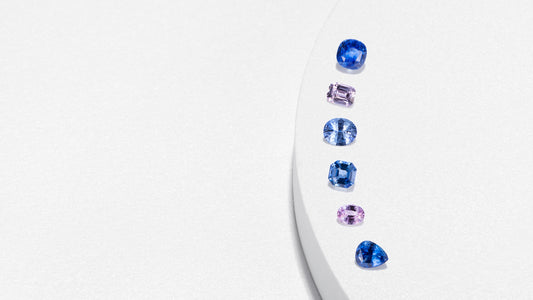
SOURCING
- Mining practices in use today have centuries of tradition behind them. Thousands of pits measuring 2x2 or 2x4 meters and between 5 and 25 meters deep are found in the common mining areas of Ratnapura (which literally means city of gems), Elahera, and Balangoda. The miners dig down until they reach the gem-bearing gravels, which they haul up by hand for washing in hopes of finding gemstone treasure.
- These traditional mining methods have maintained gemstone supplies for centuries and provided opportunities for large numbers of miners. methods are environmentally sound, as Sri Lanka requires that the pits and environment be restored after mining. This philosophy allows mining and agriculture to coexist, with miners sometimes working in rice paddies.
- Sri Lanka is a major global cutting centre for coloured stones, particularly sapphire. Cutting in Sri Lanka often relies on decades of experience rather than sophisticated or automated techniques. Sri Lankan cutters are globally renowned for their expertise in orientating rough crystals in a way that displays the maximum amount of colour saturation in a finished gem, and for being able to maintain impressively high yields from rough crystals once cut. They are also experts in the practice of heat treatment of sapphire to enhance colour and clarity/transparency.
- We buy directly from Sri Lankan cutters based predominantly out of Beruwala and Colombo.
CHARACTERISTICS
Montana is the only state in the USA that produces a significant quantity of gem quality sapphires, earning it the nickname “the Treasure State”. Montana sapphires are primarily known for their attractive oceanic teal blues and a very wide range of unheated pastel colours.
Because of the material’s typically pale colour saturation it is often heated to create a deeper, more vivid body colour and also to improve clarity/transparency.
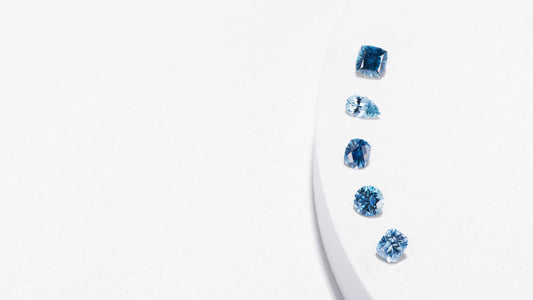
SOURCING
- The history of the American West is told in stories of frontiersmen seeking fortune in gold and other precious metals. It was coincidental that these intrepid pioneers arrived in western Montana and discovered strange, shiny pebbles (sapphires) while looking for gold.
- The sapphires were initially a nuisance to the gold miners, but they gradually formed a reputation for themselves in global gem markets over time. More than 100 years later, this legacy of mining in Montana is carried on by several sapphire mines in areas such as Rock Creek, El Dorado Bar and Spokane Bar along the upper Missouri River.
- These are generally small-scale, independent operations consisting of a small team of miners, some mechanised excavation equipment, and a mechanised wash plant used to process ‘pay dirt’ by separating heavy gem-bearing gravels from worthless tailings and overburden.
- The vast majority of Montana’s rough material remains in the United States where it is finished by local cutters. American cutters are known for their high level of precision and craftsmanship, as well as their creativity. We source all of our Montana sapphires directly from American cutters who we have formed relationships with over time.
CHARACTERISTICS
Australia is another source of beautiful and unique sapphires. Historically overlooked by the world market because of the large amount of commercial quality dark blue/black Australian sapphires that entered the market in the 1980s.
Australian sapphires can actually be found in a wide range of hues including deep blues, medium toned greenish blues, pure greens, yellows, and the rare and always unique “parti”. Today, fine quality Australian sapphires are renowned worldwide. Hues that are rare on the world market but comparatively common in Australian material (such as pure greens and partis) now sell for a premium.
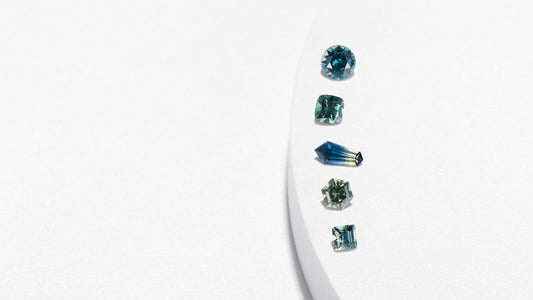
SOURCING
- Our Australian sapphires are sourced directly from artisanal miners and cutters located in either the Central Queensland gemfields area (Rubyvale, Sapphire), or northern New South Wales near the town of Inverell.
- Australian sapphires are cut by highly skilled and experienced local gem cutters. Their standard of cutting is world class and quality is very much favoured over quantity, compared to the commercial mass-production cutting techniques used in South East Asian cutting houses who typically emphasise quantity over quality.
CHARACTERISTICS
Madagascan sapphires come in an incredibly wide range of hues including rich cornflower blues, teals, greens, yellows, purples, vivid pinks and pastel peaches - and even pure red rubies.
Madagascan rough crystals can regularly reach sizes in excess of 10 carats and are known for their excellent quality and high clarity.
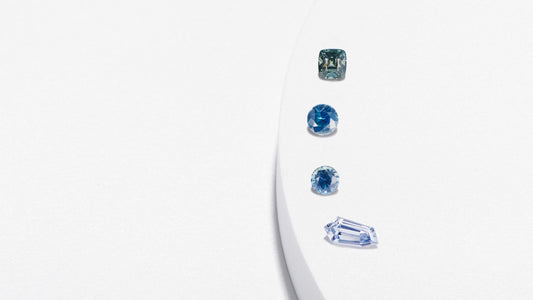
SOURCING
- The first discovery of sapphires in Madagascar occurred in 1998, near Ilakaka. Because the village was near Route Nationale 7 (RN7), the main road linking the capital city Antananarivo to the port of Toliara, the locals quickly found a thriving market with Thai and Malagasy merchants. Within months, miners from around the island settled near the bridge on the Ilakaka River, and a boomtown was born.
- Located in the south of the island, the Ilakaka area is one of the world’s largest sapphire deposits, and currently one of the most active. Potential sapphire deposits cover an area of about 75x62 miles (120x100 km). Miners seek sapphire-rich layers concentrated in former river beds that geologists call paleochannels. Using hand tools, they dig simple pits to reach the gems, which they wash in nearby rivers. The pits are often less than a meter in diameter to minimize the risks of collapse. Some pits go as deep as 60 metres.
- Because sapphire mining in Madagascar is a relatively new industry the country has yet to establish its own cutting industry. This means that rough material is usually purchased directly from miners by Sri Lankan or Thai traders who export it to their home countries to be cut into finished gems. Because of this we actually source the majority of our Madagascan sapphires from cutters in either Sri Lanka or Thailand. However, the hope is that this will soon change because in 2003 the Madagascan Ministry of Mines opened the Gemmological Institute of Madagascar (IGM), in partnership with the Gemmological Association of London, who run courses in gemmology, lapidary (cutting), and jewellery making. Its aim is that through education the country will be able to establish itself as a major manufacturing and trading centre in the same way Sri Lanka and Thailand are today, creating jobs and keeping a higher proportion of the profit from finished stones and jewellery in the country.
SAPPHIRE QUALITY & VALUE
When assessing the quality/value of the sapphire the same philosophy of the 4 C’s is applied: colour, clarity, cut, carat. However there are also other factors which can influence the value of a sapphire including treatments, origin, and the global supply and demand for certain colours.
Whilst colour and clarity will to a large extent determine the value of a sapphire, there is no official grading system for sapphires like there is for diamonds. Gem certificates for coloured stones normally only state the following - carat weight, shape, transparency, hue, dimensions, whether it’s natural or synthetic, and whether it has any detectable treatments.
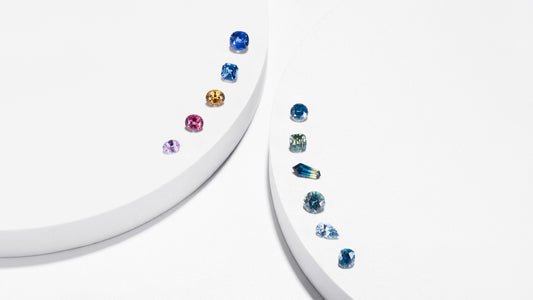
COLOUR
Colour generally has the greatest influence on the value of a sapphire. The three components to consider in regards to colour are: hue; saturation; and tone. The hue is the basic impression of the colour (i.e green or blue), the saturation is how vivid or intense the hue is, and the tone is the relative lightness or darkness of the hue. The combination of these three components determine the value of the stone with respect to colour.
KEY LESSONS
- Sapphires with strong to vivid colour saturation are more rare and desired and therefore more valuable.
- Sapphires of medium tone are generally more valuable than those of light or dark tone.
- Certain colours/tones/saturations do have more or less market value than others depending on rarity and global trends. For example, one will pay a lot more for famous colours such as “Royal Blue”, “Cornflower Blue”, or “Padparadscha”, as they have a reputation formed over a long period of time which has driven demand, and therefore, value upwards.
- However you can find sapphires of equal/higher quality in less known niche colours such as teal/green/peach/yellow/pastel for a lower price as they don’t (yet) have the famous name or reputation associated with them.
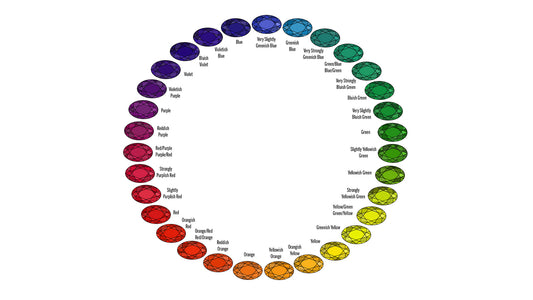

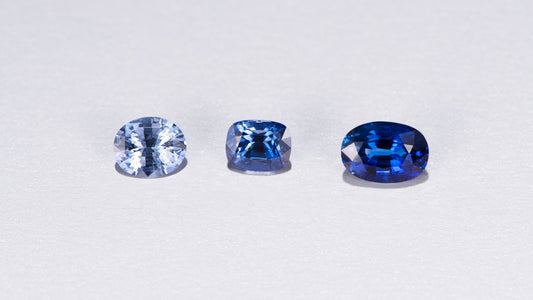
CLARITY
There is no recognised clarity grading system for sapphires. Unlike with diamonds, you should expect to see inclusions clearly with a loupe. Sapphires are therefore not scrutinised as harshly as diamonds under magnification and are more commonly judged for clarity with the naked eye.
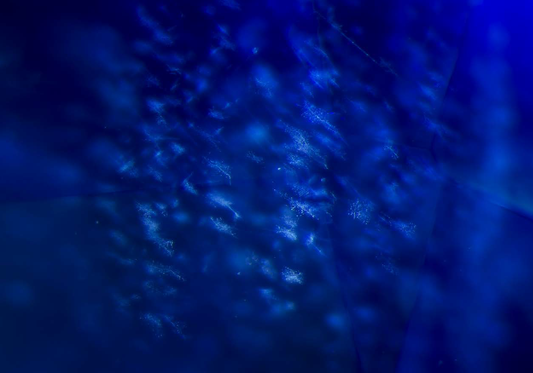
KEY LESSONS
- Sapphires of high transparency with no inclusions visible to the naked eye are very rare - they will almost always contain some small inclusions which can be found with magnification (afterall, a sapphire’s blue color is actually caused by a dissolution of an inclusion known as rutile silk). The most important thing with sapphire clarity is that it is mostly eye clean (considered desirable and sufficient in the trade), and has good transparency (i.e. not hazy/milky or opaque).
HEAT TREATMENT
Traditional heat treatment or enhancement of sapphires is very common practice within the gem industry, and the majority of sapphires on the market (estimated to be around 97%) have been subjected to some form of heat treatment. Heating a stone is performed after the gem is mined in order to enhance a sapphire's colour, dissolve ‘silk’ rutile needles, remove colour zoning and make the stone visibly clearer.
The results of traditional heat treatment are permanent, and heating is considered to be a natural treatment if no extra chemicals or additives are used. It is simply a continuation of the heating that occurs when a gemstone is formed in the earth. To differentiate between a heated and unheated sapphire can be extremely difficult, even under a microscope. Unheated sapphires are much more rare than heated sapphires and can affect the value either slightly or significantly, depending on the colour and global demand for that colour.
Unnatural treatments that use chemicals to enhance the colour or clarity of a sapphire should be disclosed by sellers of sapphires as they can make the sapphire appear a lot more valuable than it really is. We avoid any sapphires that have unnatural treatment methods such as fracture filling and Beryllium diffusion.
EMERALDS
Fine quality Colombian emeralds are one of the most highly sought after gemstones in the world. Our Gemologist Hamish Whiting, spent years living in Colombia pursuing his passion for emeralds, while establishing trusted local contacts. All Cushla Whiting emeralds are ethically sourced directly from Colombia. We are lucky enough to have a small collection of emeralds from the Muzo emerald mine.
Muzo is the oldest and most revered emerald mine in the world, prized for its high quality emeralds of ideal colour. Muzo emeralds are the standard by which all other emeralds are measured. Furthermore, they are completely mine to market, with the rough being extracted and then cut and polished at the Muzo headquarters. Each Muzo emerald is individually numbered and can be traced back to the ‘rough’ it originated from. Muzo is recognised as an industry leader in its commitment to social, ethical and environmental responsibility.

TREATMENTS IN EMERALDS
Due to the naturally more fragile nature of emeralds, the vast majority have received some treatment to enhance their appearance and durability. With most emeralds coming from Colombia or Zambia you need to be extremely careful to ensure that you know what treatment the emerald has received as there are many treatments used in these countries that are unstable and can dramatically increase the apparent value of a stone.
Our Gemologist only buys emeralds that have only had minor cedar wood oil treatment. This is a stable treatment and means that the emerald only requires a minor amount of oil, so are naturally already more durable than those which have required more significant amounts of oiling or other treatments such as fracture filling.
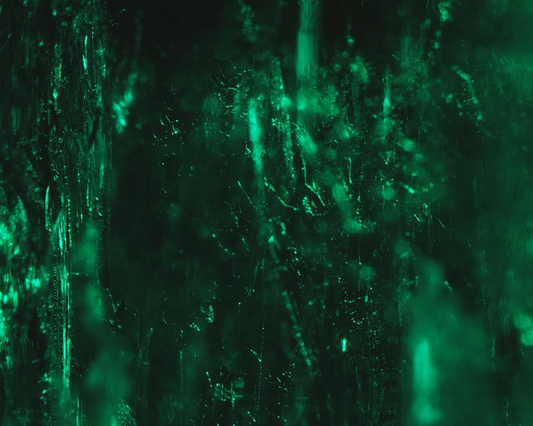
EMERALDS VALUE
The quality of emeralds can range enormously. Quality, not size, is the major factor in the value of an emerald, the quality being a combination of the intensity of color and the transparency of the crystal.
Origin can also affect value as this largely determines the colour quality, for example, Colombian emeralds are more valuable than African emeralds due to their superior pure green hue. Even the different mines within Colombia produce different quality emeralds which has an effect on price.

SPINELS
Spinels are a lustrous and durable gemstone that come in a range of hues such as deep teals, dark blues, vivid reds, pinks, metallic greys. Cushla Whiting spinels originate from both Sri Lanka and Vietnam.
Spinels are a common favourite of gemologists due to their durability, clarity, lustre, and rarity at reasonable price points.
